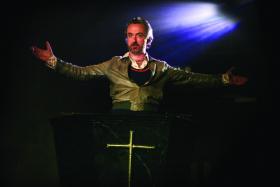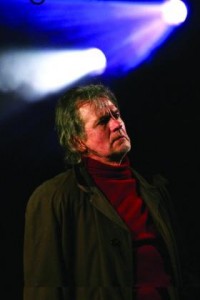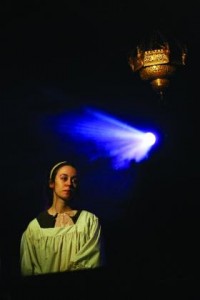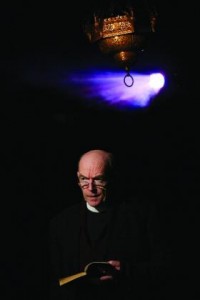Theatre eye
Published in 20th-century / Contemporary History, Issue 3 (May/June 2010), Reviews, Volume 18The Sanctuary Lamp

In a series of scintillating speeches, Francisco (Declan Conlon) performs a blasphemous sermon from the pulpit with the crucifix as a kind of fallen angel, railing against the church as ‘a poxy con’.
(All images: Anthony Wood)
Written and directed by Tom Murphy, B*spoke Theatre Company
Arcola Theatre, London, 10 March–3 April
Everyman Palace Theatre, Cork, 12–17 April
Civic Theatre, Dublin, 20–24 April
Riverbank Arts Centre, Newbridge, 26–28 April
Townhall Theatre, Galway, 4–7 May
by Eamon O’Flaherty
A brilliant production of Tom Murphy’s classic play dealing with themes of religious illusion and disillusion opened in the Arcola Theatre in Dalston, north-east London, in March and has since toured Ireland. Just now some critics are wondering whether Irish theatre is too much concerned with the past, as instanced by Thomas Kilroy’s recent acclaimed adaptation of Wedekind to the exploration of the 1950s, Christ Deliver Us, or Sebastian Barry’s recent play Tales of Ballycumber, whose message seemed to be hopelessly lost amid the echoes of its own tradition. Using drama to explore and confront the recent past is no bad thing, particularly given the human challenges of the legacies from the recent past with which Irish society is coming to terms these days.

Harry (Robert O’Mahoney), the half-Jewish Englishman who is running away from his losses.
The Sanctuary Lamp is a variation on this current useful trend because it comes from that past, or more precisely belongs to an important moment of transition in Irish society when the monolithic union of church and state was showing signs of stress. By 1975, when the play was first performed at the Abbey, Tom Murphy already had a reputation as a playwright who challenged complacencies. His first play, A Whistle in the Dark, was rejected for the Abbey in 1961 by Ernest Blythe, who objected to the depiction of a brutal and dysfunctional family of Irish emigrants in England. This didn’t prevent the play from becoming a major success in the West End in London, impressing critics like Kenneth Tynan by its dramatic violence. Murphy returned to Ireland in the early 1970s and The Sanctuary Lamp reflected both his immersion in the traditions of the classical and European theatre during his London period and the enduring anger and ability to dramatise conflicts that were central to Irish experience in a period of social change. Despite the fact that the play was not obviously intended as public commentary, does not have an Irish setting and explores universal themes, the 1975 performances were greeted with vocal objections in the theatre and nightly walkouts by members of the audience, although it also found ardent defenders. Murphy’s play had earned the honourable distinction, shared with Synge and O’Casey, of scandalising a section of the audience. Thirty-five years on, how does the play wear with time? Has it still retained the ability both to shock and to impress its audience? Classical and therefore timeless as it is in many ways, does it bring us back to those interesting times of the mid-’70s when an increasingly urgent clash between secularists and traditionalists was completely unresolved?
The play takes place over one day and night in a church in an anonymous English city. Three lost characters take refuge in a church run by a monsignor who seems unsure of why he is there or what went wrong. He would rather be at home reading Herman Hesse. The three refugees are a young girl, Maudie, and two members of a circus troupe fallen on hard times—Harry, the half-Jewish Englishman who is running away from his losses to find sanctuary in the empty church, and Francisco, a young Irishman who is at once Harry’s friend and antagonist. The other presence in the play is the sanctuary lamp itself, casting the other characters into the shadows and acting as the focus of their limping efforts to find ways of understanding the loss of those close to them: Maudie’s mother and her baby; Harry’s daughter; and his wife, stolen from him by Francisco. The first act closes on a note of uncertainty and menace—Harry and Maudie trying to create a small domestic space among symbols they cannot really understand, and Francisco infiltrating the church and threatening the fragile stability of the other two. The play comes to life dramatically in the second act with the entry of Francisco, disillusioned pupil of the Jesuits, who delivers some of the most powerful and memorable of the speeches in a great performance by Declan Conlon. The cathartic moment of the play comes when Harry, seeking revenge on Francisco and wielding a knife, provokes him into a series of diatribes against Christianity. In a series of scintillating speeches, Francisco performs a blasphemous sermon from the pulpit with the crucifix as a kind of fallen angel, railing against the church as ‘a poxy con’:

Maudie (Kate Brennan), one of the three lost characters who take refuge in the church.
‘. . . all those predators that have been mass-produced out of the loneliness and isolation of people, with standard collars stamped on! And what do they give back? They’re like black candles, not giving, but each one drawing a little more light of the world.’
Yet in Murphy’s production the same character provides the way out which deflects Harry’s knife of vengeance, when he throws open his arms and echoes the Gethsemane injunction: ‘Put away your sword’.
There is indeed a kind of religious affirmation in the play’s climactic scene, when Francisco, like Martin Luther King, has a dream:
‘I have a dream, I have a dream! . . . when Jesus, Man, total man, will call to his side the goats—“Come ye blessed”. Yea, call to his side all those rakish, dissolute, suicidal, fornicating goats, taken in adultery and what-have-you. And proclaim to the coonics [clergy], blush for shame, you blackguards, be off with you, you wretches, depart from me ye accursed complicated affliction.’
Harry relights the sanctuary lamp and the characters, lying side by side in the overturned confessional, weave a sort of vernacular mysticism out of their common sense of loss. What seemed to many an assault on religion nowadays looks like quite a religious play, rather pointedly showing up the irrelevance of traditional structures in helping people find forgiveness or redemption. Murphy once described his sense of rage in the face of inequality—not inevitable human inequalities, but ‘rage against the inequalities, the arrogance of power’. Echoes of Dostoievsky and Brecht, indeed, but Murphy’s was also a prophetic Irish voice in the context of the time. HI
Eamon O’Flaherty lectures in history at University College Dublin.

The monsignor (Bosco Hogan) would rather be at home reading Herman Hesse. The other presence in the play is the sanctuary lamp itself, casting the other characters into the shadows.
















